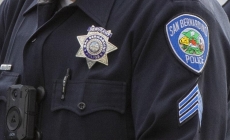-
In War-Torn Nations, Trump’s Travel Ban Brings a New Hardship - 19 hours ago
-
As Trump Says He’s Stamping Out Antisemitism, He Advances Similar Tropes - June 3, 2025
-
How a former factory worker rose to South Korea’s presidency - June 3, 2025
-
$105 Million Reparations Package for Tulsa Race Massacre Unveiled by Mayor - June 1, 2025
-
Israel Bars Arab Foreign Ministers From High-Level West Bank Visit - May 31, 2025
-
Central California carjacking was an insurance scam, investigators say - May 31, 2025
-
U.S. Pauses Exports of Airplane and Semiconductor Technology to China - May 29, 2025
-
Missing California influencer found dead near Arizona hiking trail - May 28, 2025
-
A Vermont Start-Up Was Close to Becoming Profitable. Then the Tariffs Hit. - May 27, 2025
-
Russia Intensifies Attacks on Ukraine as U.S. Steps Back - May 26, 2025
Winter Storm Brings a Brutal Mix of Snow, Bitter Cold and Rain Across U.S.
Residents in Billings, Mont., woke up to a temperature of minus 25 degrees Fahrenheit. In Des Moines, homeowners were digging out snow and facing wind gusts of 45 miles per hour. Residents in Paterson, N.J., were evacuated from flooded homes. And communities near the Gulf Coast were preparing for a deep freeze.
More than 40 million Americans were under winter weather advisories on Saturday, according to the National Weather Service, from rain to high winds to heavy snow, and a large portion of the United States was expected to face the coldest conditions of winter so far in the coming days.
Here is a look at some of what’s going on around the country.
The Midwest After the Blizzard
Some Iowans spent Saturday morning bundling up and digging out their driveways and walkways; the temperature was 1 degree at one point, with a wind chill of minus 45. In Des Moines, the main thoroughfares were drivable but still covered in snow and hazardous. Many rural highways remained impassable.
The Iowa State Patrol said that from 12:30 a.m. on Friday to 10 a.m. on Saturday, it responded to 535 motorist assist calls and 86 crashes, none fatal.
At a truck stop in Urbandale on Saturday morning, Amir Ford, a 24-year-old trucker who was hauling a load of glass doors, was trying to decide whether to continue his journey east to Chicago after a harrowing drive up I-35.
“It’s treacherous. It’s cold, it’s icy, it’s bad,” he said, adding that he saw multiple vehicles in ditches along the route.
At around 2 p.m. Eastern, officials in Iowa noted deteriorating conditions, as more snow and high winds arrived. By late Saturday afternoon, blizzard conditions were reported in parts of the state.
Blizzard warnings remained in effect for much of the day in many states, including for parts of North Dakota, South Dakota and Nebraska. And areas of Michigan, Indiana and Minnesota faced additional snowfall.
In Lincoln, Neb., where temperatures hovered just below zero, Erin Patton, 46, picked up ingredients for chili and cinnamon rolls at a Hy-Vee market, as employees scrambled to restock bare shelves.
“I’m definitely looking forward to getting home and getting under the blankets,” she said. “This cold is something else.”
Flooding in the Northeast
In Maine, the storm brought record-breaking water levels to parts of its coast on Saturday, leading to extensive flooding in at least one area.
In South Portland, three century-old fishing shacks that had been recently restored were swept away in the storm surge that sent a wall of waves crashing onto Willard Beach on Saturday. The city had “just rehabbed them to sturdy them up to make sure they stayed,” Lt. Kevin Theriault of the city’s Police Department said in an interview.
The waves cleared the houses from the point above Simonton Cove. Seawater crashed over the city’s rock walls, submerging the benches three and a half feet above sea level in a park, Lieutenant Theriault said. “We’ve never had it come this high,” he said of the water.
Phil Selberg, the South Portland fire chief, said emergency worked helped a few people out of cars stuck in floodwaters at the peak of the storm on Saturday, but that no injuries were reported.
Parts of New York, New Jersey and Connecticut have experienced nearly two inches of rainfall since Friday, according to the Weather Service.
That precipitation, which lasted overnight into Saturday, caused flooding in parts of New Jersey and led to evacuations of residents living near the Passaic River in Paterson and Little Falls.
In New York City, parts of the Henry Hudson Parkway, which runs along the west side of Manhattan, were closed because of flooding.Due to high winds, empty tractor-trailers and tandem trailers were temporarily banned on the Robert F. Kennedy Bridge.
As Saturday’s storm started to wind down in New England, flooding brought on by heavy rain and high tides caused evacuations in Rhode Island and New Hampshire.
Plunging Temperatures in the South
Temperatures in many areas began plummeting on Saturday, and forecasters said that would continue into next week.
In Oklahoma, the Weather Service said that “dangerously cold wind chills” — as low as minus 25 degrees — were to be expected at times, beginning Saturday night. Officials are urging residents to avoid outdoor activities.
Alabama could get up to four inches of snow beginning Sunday night, forecasters said. A winter storm watch is in effect for many counties in Tennessee from Sunday to Tuesday morning, with temperatures expected to drop on Saturday night to as low as the teens and snow expected beginning Sunday evening, the National Weather Service said.
And the governors of Louisiana and Arkansas declared states of emergency ahead of worsening conditions expected this weekend. “This will be dangerous cold, so the time to prepare is now!” the Weather Service in Little Rock warned.
In Amarillo, Texas, on Saturday, it was 10 degrees by midday. In the flat, dormant pastureland, ranchers have been feeding their cattle more in anticipation of the frigid weather, so they can stay warm, said J.D. Ragland, a Texas A&M University agriculture expert in Randall County.
“Long episodes of extremely cold weather in our part of the world, we’re just simply not used to,” Dr. Ragland said.
Snow and Frigid Temperatures in the West
Parts of Wyoming, Oregon, Northern California, Colorado, Nevada, Utah and Alaska were under winter storm warnings and wind chill warnings on Saturday, with low temperatures and heavy snow expected in some areas and freezing rain possible.
On Saturday afternoon, heavy snow was being reported in parts of Idaho.
In Sacramento, snow covered roads in the Sierra Nevada caused “hazardous travel,” officials said.
In Montana, temperatures of minus 40 or minus 50 were possible on Saturday. Flood advisories in some areas of the state also remained in effect on Saturday.
Power Outages and Flight Disruptions
In the Great Lakes region on Saturday afternoon, just under 220,000 households were without power, according to PowerOutage.us, and in Oregon, more than 120,000 customers were without electricity.
Thousands of people across the Northeast also experienced outages on Saturday. In New England, most of the outages were in Vermont, Rhode Island and New Hampshire, where high wind gusts of 30 m.p.h. or more had been predicted overnight.
In air travel, there were more than 1,200 flight cancellations and more than 4,300 flight delays within, into or out of the United States by Saturday afternoon, according to FlightAware, a tracking site. Cancellations were reported at airports including Chicago’s O’Hare Airport, Detroit’s Metro Wayne County Airport, Denver International Airport and Buffalo’s Niagara International Airport. On Friday, the storm disrupted more than 10,000 flights across the country.
How the Iowa Caucuses Have Been Hit
This is the final weekend before the Iowa caucuses, and Republican presidential candidates are battling two forces: the brutally cold temperatures and the threat of low voter turnout as they navigate the dangerous, icy roads and winds.
Candidates have maintained a more regular schedule Saturday after being forced to cancel many events Friday.
Still, in Des Moines, the National Weather Service urged drivers to stay off the roads amid a storm that was once in a generation. A measurement at the Des Moines airport recorded 22.3 inches of snow so far this week, the most in a five-day period since 1941, according to the National Weather Service.
A Different Environment for N.F.L. Playoff Games
In New York, Gov. Kathy Hochul announced on Saturday that the playoff game in Buffalo between the Bills and the Pittsburgh Steelers, which had been scheduled for Sunday afternoon, will be postponed to 4:30 p.m. on Monday, citing “dangerous conditions.”
Forecasters in Erie County, which includes Buffalo, said that the snow totals could reach up to two feet and that blizzard conditions were possible on Saturday night and Sunday.
In Kansas City, where the defending Super Bowl champion, the Chiefs, hosted the Miami Dolphins in a wild-card playoff game on Saturday night, the temperature was minus 4 degrees at kickoff, with a wind chill of minus 27.
Still, Tyler Shannon, 36, of Shawnee, Kan., went to the game, celebrating a friend’s birthday. He braved through the cold in a heated vest, battery-powered heated socks, several layers and ski goggles.
“You definitely have to have everything covered,” he said from the game. “Everyone has blankets, has the gloves and face gear going on,” he added.
But the stadium was still full, Mr. Shannon said, calling the atmosphere “electric.” “Everyone’s really having a good time. I think they’re making the most of it.”
Judson Jones, Colleen Cronin, Lauryn Higgins, Adam Nagourney and Joel Wolfram contributed reporting.










